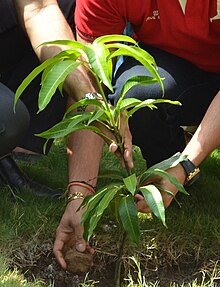
Back إزالة ثنائي أكسيد الكربون Arabic কার্বন ডাই অক্সাইড অপসারণ Bengali/Bangla Eliminació de gasos d'efecte hivernacle Catalan Odstraňování oxidu uhličitého Czech Negative Emissionen German Extracción de dióxido de carbono Spanish Élimination du dioxyde de carbone atmosphérique French Rimozione dell'anidride carbonica Italian Koldioxidinfångning Swedish Karbondioksit giderme Turkish

Carbon dioxide removal (CDR) is a process in which carbon dioxide (CO2) is removed from the atmosphere by deliberate human activities and durably stored in geological, terrestrial, or ocean reservoirs, or in products.[3]: 2221 This process is also known as carbon removal, greenhouse gas removal or negative emissions. CDR is more and more often integrated into climate policy, as an element of climate change mitigation strategies.[4][5] Achieving net zero emissions will require first and foremost deep and sustained cuts in emissions, and then—in addition—the use of CDR ("CDR is what puts the net into net zero emissions"[6]). In the future, CDR may be able to counterbalance emissions that are technically difficult to eliminate, such as some agricultural and industrial emissions.[7]: 114
CDR includes methods that are implemented on land or in aquatic systems. Land-based methods include afforestation, reforestation, agricultural practices that sequester carbon in soils (carbon farming), bioenergy with carbon capture and storage (BECCS), and direct air capture combined with storage.[7]: 115 There are also CDR methods that use oceans and other water bodies. Those are called ocean fertilization, ocean alkalinity enhancement,[8] wetland restoration and blue carbon approaches.[7]: 115 A detailed analysis needs to be performed to assess how much negative emissions a particular process achieves. This analysis includes life cycle analysis and "monitoring, reporting, and verification" (MRV) of the entire process.[9] Carbon capture and storage (CCS) are not regarded as CDR because CCS does not reduce the amount of carbon dioxide already in the atmosphere.
As of 2023, CDR is estimated to remove around 2 gigatons of CO2 per year.[10] This is equivalent to about 4% of the greenhouse gases emitted per year by human activities.[11]: 8 There is potential to remove and sequester up to 10 gigatons of carbon dioxide per year by using those CDR methods which can be safely and economically deployed now.[11] However, quantifying the exact amount of carbon dioxide removed from the atmosphere by CDR is difficult.
- ^ Buis, Alan (November 7, 2019). "Examining the Viability of Planting Trees to Help Mitigate Climate Change". Climate Change: Vital Signs of the Planet. Retrieved April 13, 2023.
- ^ Marshall, Michael (May 26, 2020). "Planting trees doesn't always help with climate change". BBC. Retrieved April 13, 2023.
- ^ IPCC, 2021: "Annex VII: Glossary". Matthews, J.B.R., V. Möller, R. van Diemen, J.S. Fuglestvedt, V. Masson-Delmotte, C. Méndez, S. Semenov, A. Reisinger (eds.). In "Climate Change 2021: The Physical Science Basis. Contribution of Working Group I to the Sixth Assessment Report of the Intergovernmental Panel on Climate Change". Masson-Delmotte, V., P. Zhai, A. Pirani, S.L. Connors, C. Péan, S. Berger, N. Caud, Y. Chen, L. Goldfarb, M.I. Gomis, M. Huang, K. Leitzell, E. Lonnoy, J.B.R. Matthews, T.K. Maycock, T. Waterfield, O. Yelekçi, R. Yu, and B. Zhou (eds.). Cambridge University Press, Cambridge, United Kingdom and New York, NY, USA, pp. 2215–2256, doi:10.1017/9781009157896.022
- ^ Schenuit, Felix; Colvin, Rebecca; Fridahl, Mathias; McMullin, Barry; Reisinger, Andy; Sanchez, Daniel L.; Smith, Stephen M.; Torvanger, Asbjørn; Wreford, Anita; Geden, Oliver (March 4, 2021). "Carbon Dioxide Removal Policy in the Making: Assessing Developments in 9 OECD Cases". Frontiers in Climate. 3: 638805. doi:10.3389/fclim.2021.638805. hdl:1885/270309. ISSN 2624-9553.
- ^ Geden, Oliver (May 2016). "An actionable climate target". Nature Geoscience. 9 (5): 340–342. Bibcode:2016NatGe...9..340G. doi:10.1038/ngeo2699. ISSN 1752-0908. Archived from the original on May 25, 2021. Retrieved March 7, 2021.
- ^ Ho, David T. (April 4, 2023). "Carbon dioxide removal is not a current climate solution — we need to change the narrative". Nature. 616 (7955): 9. Bibcode:2023Natur.616....9H. doi:10.1038/d41586-023-00953-x. ISSN 0028-0836. PMID 37016122. S2CID 257915220.
- ^ a b c M. Pathak, R. Slade, P.R. Shukla, J. Skea, R. Pichs-Madruga, D. Ürge-Vorsatz,2022: Technical Summary. In: Climate Change 2022: Mitigation of Climate Change. Contribution of Working Group III to the Sixth Assessment Report of the Intergovernmental Panel on Climate Change [P.R. Shukla, J. Skea, R. Slade, A. Al Khourdajie, R. van Diemen, D. McCollum, M. Pathak, S. Some, P. Vyas, R. Fradera, M. Belkacemi, A. Hasija, G. Lisboa, S. Luz, J. Malley, (eds.)]. Cambridge University Press, Cambridge, UK and New York, NY, USA. doi: 10.1017/9781009157926.002.
- ^ Cite error: The named reference
wri-oceanwas invoked but never defined (see the help page). - ^ Schenuit, Felix; Gidden, Matthew J.; Boettcher, Miranda; Brutschin, Elina; Fyson, Claire; Gasser, Thomas; Geden, Oliver; Lamb, William F.; Mace, M. J.; Minx, Jan; Riahi, Keywan (October 3, 2023). "Secure robust carbon dioxide removal policy through credible certification". Communications Earth & Environment. 4 (1): 349. Bibcode:2023ComEE...4..349S. doi:10.1038/s43247-023-01014-x. ISSN 2662-4435.
- ^ Cite error: The named reference
:10was invoked but never defined (see the help page). - ^ a b National Academies of Sciences, Engineering (October 24, 2018). Negative Emissions Technologies and Reliable Sequestration: A Research Agenda. National Academies Press. ISBN 978-0-309-48452-7. Archived from the original on November 22, 2021. Retrieved February 22, 2020.
© MMXXIII Rich X Search. We shall prevail. All rights reserved. Rich X Search